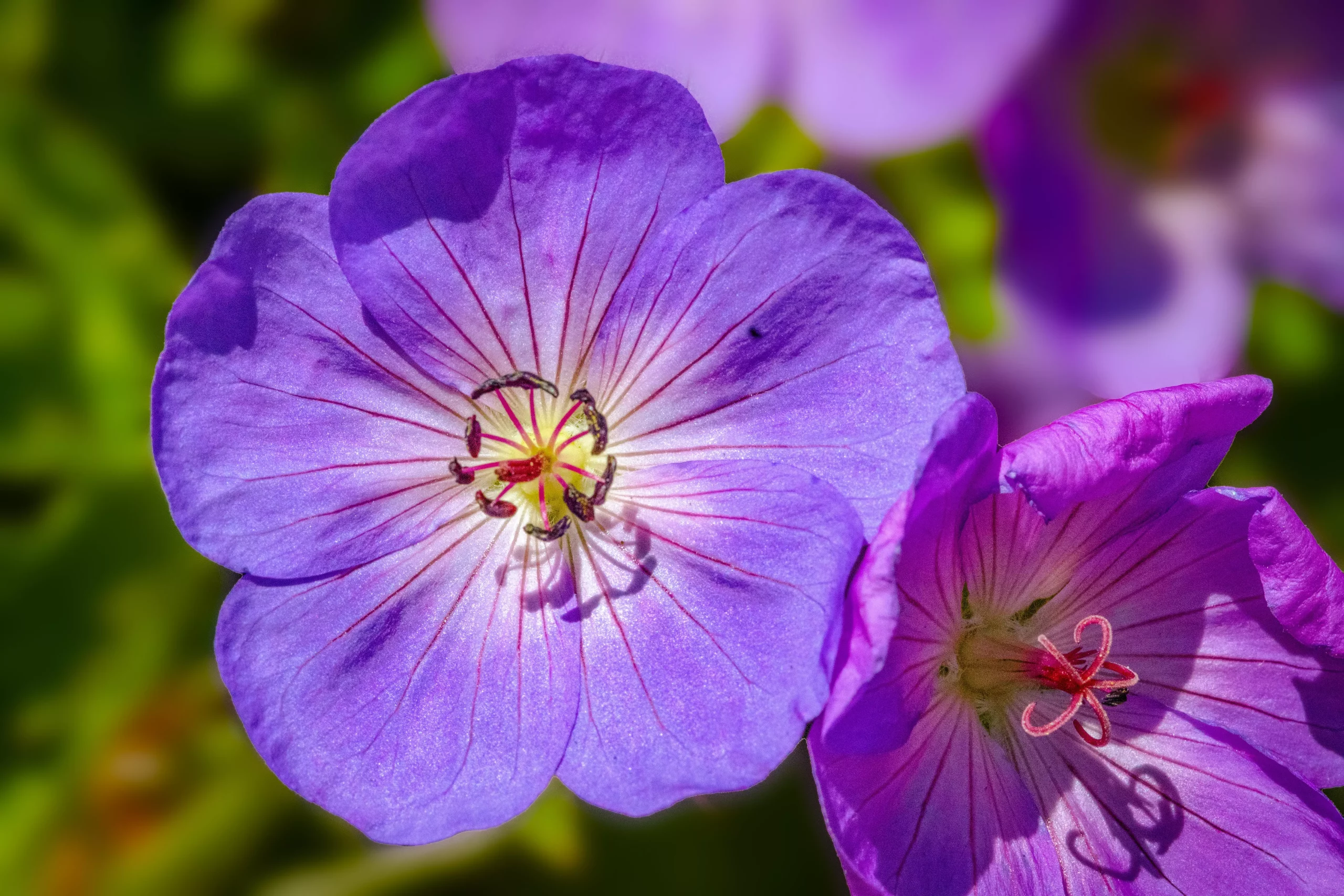
Plants in accommodation facilities
Zieleń wokół obiektu noclegowego, choć traktowana często jako “zło konieczne”, jest tak naprawdę wizytówką Waszego miejsca. To pierwszy, wizualny kontakt klienta z obiektem, co w dużej mierze warunkuje jego nastawienie i odbiór estetyczny jako całokształt. Wykorzystaj ten element oraz wartości, jakie za sobą niesie – zadbana, uporządkowana przestrzeń daje poczucie bezpieczeństwa oraz pozytywne nastawienie do miejsca, a charakterystyczna roślinność lub jej funkcjonalne zastosowanie może stać się symbolem Waszego obiektu. Obecność ogrodu, kompozycji drzew, krzewów, donicowych nasadzeń, zielonych miejsc wypoczynku może również zdecydować o wyborze obiektu, ponownej wizycie lub przyszłej rekomendacji.
Artykuł ten ma za zadanie przedstawić gatunki roślin odpowiednie dla poszczególnych zastosowań. Tych które odnajdują się znakomicie w określonej roli, jednocześnie wypełniając ogrodową przestrzeń pożądaną zielenią.
Polecamy sprawdzone rośliny na żywopłot, umocnienie skarpy, osłonę, zadarnianie powierzchni oraz na pozbycie się niewygodnych gości – komarów.

Aspekty psychologiczne zieleni, a obiekt noclegowy
Z punktu widzenia psychologicznego kolor zielony to barwa nadziei i wolności. Przeprowadzone przez University of Illinois badania dowodzą, iż samo patrzenie na ten kolor znacząco obniża poziom stresu w organizmie. Ponadto, przebywanie w “zielonym” otoczeniu pozwala lepiej dotlenić nasz organizm, przez co czujemy się odprężeni i zregenerowani. Nie bez powodu uciekamy na łono natury podczas urlopu czy wolnego weekendu – w ten sposób ładujemy swoje wewnętrzne baterie – zielony działa relaksacyjnie i uspokajająco, a tego przecież szukają Wasi goście. Warto bowiem zadbać o to, żeby Wasz gość czuł się dobrze nie tylko w zaciszu wynajętego pokoju, lecz – jeżeli macie taką możliwość – czerpał z walorów jakie niesie za sobą przyroda.
Pnącza jako osłony – naturalne fasady domów i domków
Pnącza to grupa roślin mało wymagająca, a jednocześnie bardzo wszechstronna. Na stanowiskach naturalnych wspinają się po drzewach, krzewach lub skałach. W ogrodach sytuacja może być podobna, ale chcąc mieć większą kontrolę i konkretny efekt możemy przygotować sztuczne podpory jak altany, pergole, czy kratownice, które pozwolą wykorzystać ich potencjał dla naszych celów. Ich ekspansywny charakter pozwoli na szybkie zasłonięcie mało efektownej ściany budynku, uzyskać zielone parawany chroniące przed wzrokiem ciekawskich, ukryć mniej atrakcyjne miejsca lub obiekty w ogrodzie jak kontenery na odpady czy kompostownik. Za pomocą pnączy stworzymy również romantyczne, odosobnione miejsce gdzieś na skraju działki w postaci otulonej zielenią altany.

Doskonałym zawodnikiem w tej kategorii jest winobluszcz – najbardziej popularne pnącze. Są to rośliny, które mogą osiągnąć 20 m długości i nie mają szczególnych wymagań co do stanowiska. Charakteryzują się niezwykłą żywotnością i bardzo szybkim wzrostem. W ciągu kilku lat bez trudu pokryje całą ścianę, a jedynym zabiegiem pielęgnacyjnym jakiego wymaga to regularne przycinanie po tym jak przekroczy granice które mu wytyczyliśmy.
Winobluszcze od lat z powodzeniem wykorzystywane są do zakrywania niezbyt reprezentatywnych obiektów, a także do zmiękczania surowej, betonowej infrastruktury miejskiej.
Numer jeden to winobluszcz pięciolistkowy (Parthenocissus quinquefolia). Po budynkach i ogrodzeniach wspina się dzięki wąsom czepnym zaopatrzonym na końcach w tzw. przylgi – przyssawki pomagające piąć się po chropowatych powierzchniach. Jest pnączem bardzo ekspansywnym, doskonale znoszącym cięcie. Tworzy zwarty, zielony kobierzec efektowny przez cały sezon wegetacyjny, a jesienią przybiera piękne bajkowe kolory w odcieniach czerwieni oraz purpury.
Drugą, równie często spotykaną odmianą jest winobluszcz trójklapowy (Parthenocissus tricuspidata). Nieco wolniej rosnącą ale o bardziej szlachetnym i dekoracyjnym wyglądzie niż odmiana pięciolistkowa. Jego minusem jest mniejsza mrozoodporność, atutem – charakterystyczny, dachówkowy układ liści szczelnie przykrywający powierzchnie, chroniąc je w ten sposób przed deszczem. Jesienią mieni się w odcieniach żółci, pomarańczu i czerwieni. W czerwcu na winobluszczu pojawiają się niepozorne kwiaty z których na jesień rozwijają się fioletowe, kuliste owoce. Gdy liście opadną ich widoczność jest większa – również dla ptaków dla których są przysmakiem.
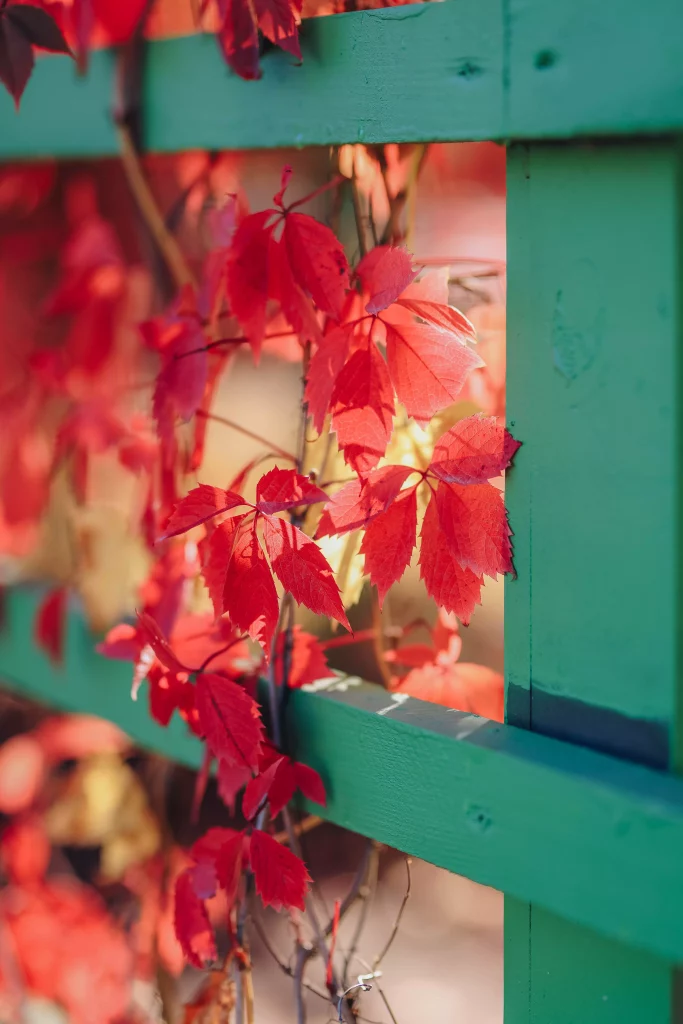
Rośliny na żywopłot dla obiektu noclegowego
Kolejną zieloną formą jaką możemy wprowadzić do ogrodowej przestrzeni jest żywopłot. Główną jego funkcją jest wyznaczanie granic, ale to nie jedyna rola jaką może odegrać w ogrodzie. Jako naturalna forma ogrodzenia w miejscach graniczących z lasem czy polami jest bezpieczną barierą dla dzikich zwierząt takich jak sarny czy dziki, które mogą spowodować szkody na trawnikach czy w warzywnikach. Żywopłoty mogą również doskonale oddzielać strefy funkcjonalne w przestrzeni, takie jak np. place zabaw, parkingi, (siłownie outdoorowe) czy dzielić część dla gości z częścią prywatną.
Za jego pomocą, zwłaszcza w niższej formie podkreślane są ciągi komunikacyjne, natomiast w wyższej z powodzeniem sprawdzają się jako naturalne bariery redukujące poziom zanieczyszczeń co sprawdza się przy obiektach graniczących z jezdnią oraz ochrony przed wiatrem. Jednakże nie zapominajmy o tym, że zielone ściany to również dekoracja i piękne tło dla barwnych krzewów i bylin, a bardziej wytrwali mogą stworzyć z niego dodatkową atrakcję w postaci labiryntów.
Grab zwyczajny (Carpus betulus) to propozycja na idealnie gęsty żywopłot – jest to roślina przyjemna w uprawie, niewymagająca, dająca się bez problemu przycinać i formować.
Tworzy doskonałą osłonę przed wiatrem, może być prowadzony w formie naturalnej lub ciętej – wszystko zależy od charakteru jaki chcemy nadać przestrzeni, a także wielkości terenu jakim dysponujemy. Grab rośnie dość szybko, a najlepszą porą na jego sadzenie jest jesień. Jest to drzewo o nietrwałych liściach, ale nie opadających tylko usychających na zimę. Jesienią zmieniają barwę na brązową i opadają dopiero wiosną (gdy pojawiają się nowe liście). Jest to jego dodatkowy walor dekoracyjny odpowiadający za pełniejszą ochronę przed wiatrem w okresie zimowym.
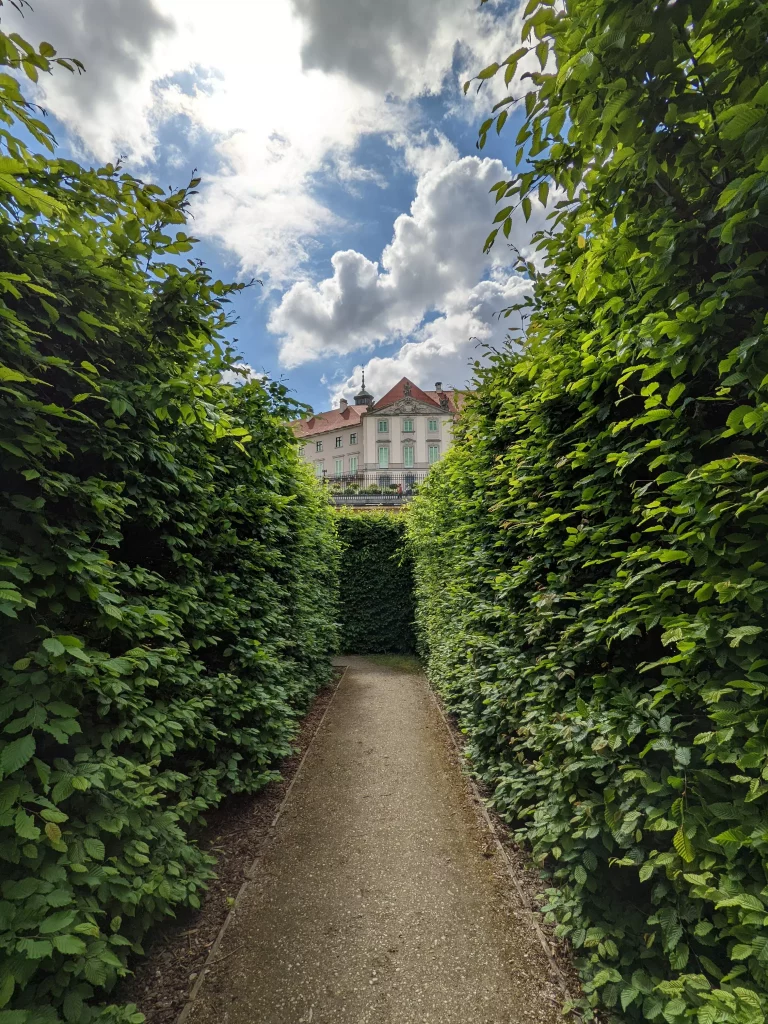
Druga propozycja na gęsty żywopłot, ale tym razem zimozielony, to cis pośredni ‘Hicksii’ (Taxus x media). Cisy to krzewy bardzo często wykorzystywane w żywopłotach ze względu na swoje niskie wymagania i łatwość uprawy. Rosną niemal wszędzie – nawet w cieniu, niezwykle dobrze znoszą cięcie i nie obawiają się niskich temperatur. Regularnie przycinany tworzy bardzo równe i proste żywopłoty, a ich głęboka zieleń jest doskonałym, całorocznym tłem dla roślin kwitnących. Do wymienionych zalet można zaliczyć fakt, że jest to iglak który nie traci swojej ciemnozielonej barwy przez cały rok.
Należy jednak pamiętać, że cisy dzielą się na okazy męskie i żeńskie. Jest to ważne z punktu widzenia dzieci gdyż okazy żeńskie mają niewielkie czerwone owoce, które wiosną dla ptaków stanowią nie lada przysmak, natomiast dla ludzi nasiona znajdujące się wewnątrz czerwonej osnówki są trujące. Aby cis owocował musimy mieć na działce dwa różne egzemplarze: męski i żeński. Mając cis tylko jednej płci, nie doczekamy się czerwonych dekoracyjnych owoców.
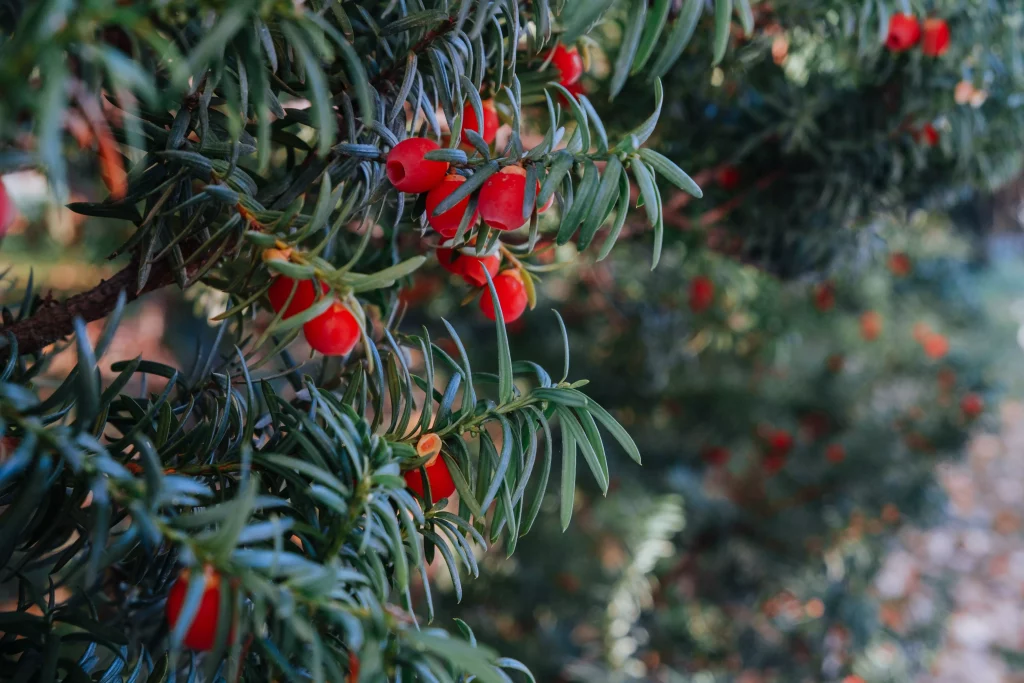
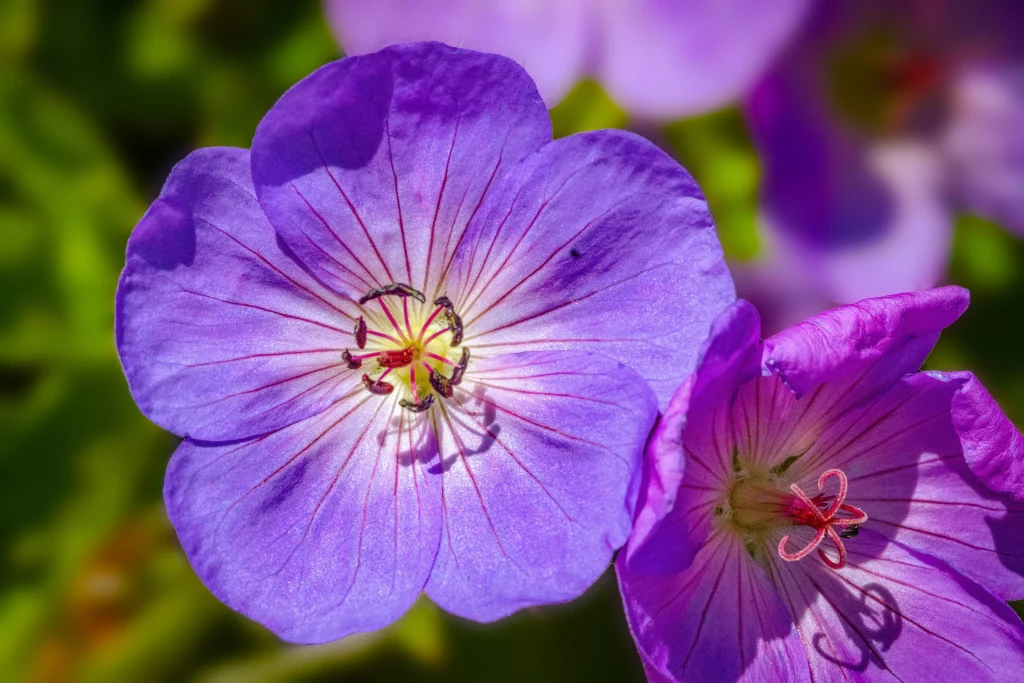
Rośliny zadarniająco-okrywowe zadbają o ogród w obiekcie noclegowym
Często w ogrodach zdarzają się miejsca mocno nasłonecznione lub mocno zacienione, w których trawniki nie utrzymują się przez co nie wyglądają reprezentacyjnie. Z kolei inne miejsca są trudno dostępne, a ich pielęgnacja bardzo kłopotliwa. Tutaj z pomocą przychodzą nam rośliny zadarniające i okrywowe, które częściowo zahamują rozrost chwastów, ochronią glebę przed wysychaniem, a jednocześnie zazielenią i udekorują nieatrakcyjny fragment bez większych zabiegów z naszej strony. Rośliny te płożą się i rozrastają na boki, tworząc po jakimś czasie zwarty kobierzec. Są nie tylko praktyczne, ale i atrakcyjne dla oka. Wiele z nich pięknie kwitnie lub jest ozdobne z liści.
W grupie roślin zadarniająco-okrywowych znajdują się zarówno byliny, jak i krzewy. Dzielą się na te, które radzą sobie w miejscach słonecznych i te które lepiej czują się w cieniu.
Dlatego przedstawimy pozycję reprezentującą jedną i drugą grupę – bylinę zadarniającą do cienia oraz krzew okrywowy na miejsce słoneczne.
Jedną z popularniejszych, tworzących zielony dywan bylin jest często spotykany choćby w parkach barwinek pospolity (Vinca minor). Jego ozdobne, skórzaste liście pięknie lśnią nawet w mocno zacienionych miejscach, a białe lub niebiesko-fioletowe kwiaty pojawiające się wiosną rozweselają ciemne zakątki. Barwinek jest rośliną szybko rosnącą, rozłogową, a jego mocne, długie pędy ukorzeniają się co pozwala mu na większą ekspansję. Dobrze znosi cięcie, więc trzymanie go w ryzach rabaty nie stanowi problemu, rośnie na każdej glebie i doskonale znosi okresowe przesuszenie.

Drugą z prezentowanych roślin jest róża okrywowa odmiany ‘The Fairy’. Ta wydawałoby się delikatna, nie kojarzona z zadarniającą funkcją roślina może nas bardzo zaskoczyć! Odmiany okrywowe to takie “superhero” wśród róż – są mrozoodporne, wytrzymałe na zanieczyszczenia, dobrze znoszące cięcie, a przy tym bardzo szybko i gęsto pokrywające obsadzoną powierzchnię. Okrywówki rozrastają się też rozłogowo, poprzez tzw. odrosty korzeniowe, co powoduje, że prócz szczelnego zadarniania, umacniają grunt, więc są również stosowane do obsadzania skarp (o tym w dalszej części artykułu). W przeciwieństwie do innych, bardzo wymagających i delikatnych odmian róż, gatunki róży okrywowej nie wymagają szczególnych zabiegów pielęgnacyjnych, ani specjalnego przygotowania podłoża, a ich naturalne piękno ciernistych pędów, obsypanych gęsto drobnymi kwiatami o ciepłych barwach zachwyca każdego. Ich największą zaletą to długi okres kwitnienia, który rozpoczyna się od wczesnego lata do pierwszych przymrozków.
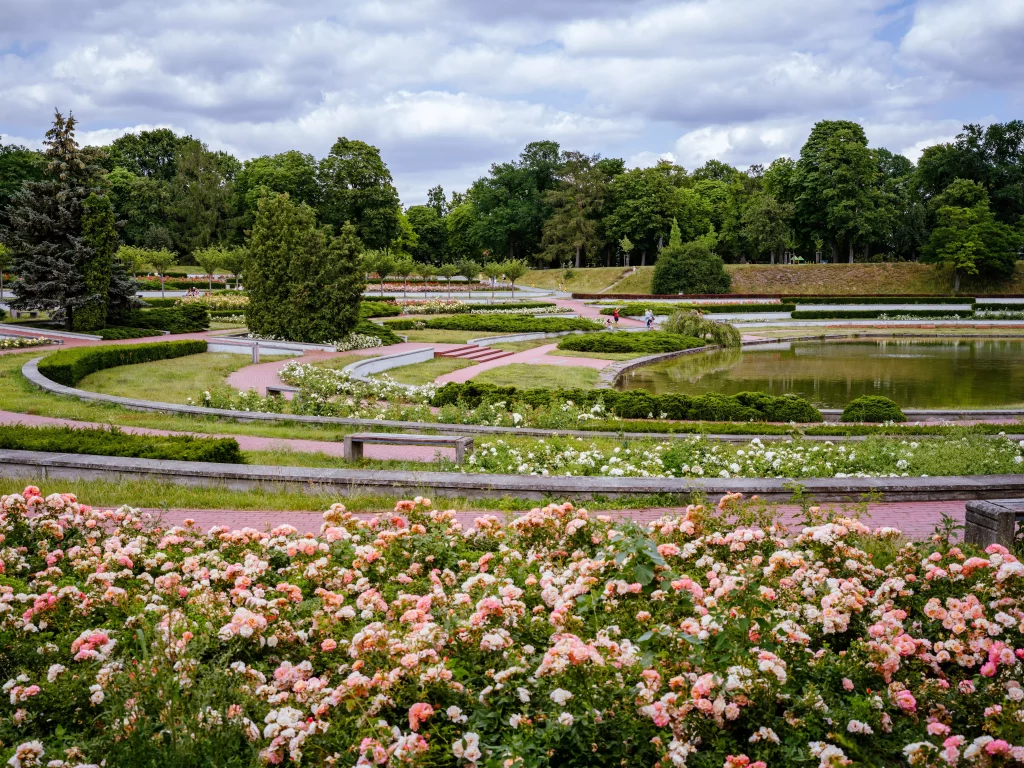
Rośliny na skarpy
Skarpy w ogrodzie to bardzo malowniczy i efektowny akcent. Jest to wynik naturalnej rzeźby terenu lub element powstały podczas budowy obiektu, łączący dwie różne wysokości poziomu gruntu. Różnią się przede wszystkim stopniem nachylenia czyli stosunkiem wysokości do szerokości. Jeżeli mamy do czynienia z jego małym stopniem możemy posiać na niej trawę lub zastosować nasadzenia bylin i krzewów których zadaniem – oprócz zdobiącego – będzie wzmocnienie i stabilizacja gruntu przed erozją. Skarpy o większym nachyleniu np. 30% i więcej wymagają odpowiedniej konstrukcji wzmacniającej, np. muru oporowego. W zależności od długości zbocza możemy to zrobić jedną wysokością muru bądź podzielić ją na kilka mniejszych formując w ten sposób schody. One również mogą być miejscem zielonych nasadzeń przełamujących niebanalną konstrukcję.
My skupimy się na roślinach które – oprócz dekoracji – zabezpieczą skarpy przed osuwaniem. Są to gatunki charakteryzujące się dosyć silnym wzrostem, niewielkimi wymaganiami glebowymi i siedliskowymi, odporne na suszę oraz z posiadające rozbudowany system korzeniowy wiążący glebę.
Jałowce płożące (Juniperus horizontalis) to świetnie sprawdzający się w roli umocnienia skarp gatunek roślin o szerokiej gamie odmian. Jedną z ciekawszych, spełniających ten warunek oraz rozjaśniający swoją barwą otoczenie jest ‘Golden Carpet’ – zimozielony, płożący iglak o zielono-cytrynowych igłach. Ma minimalne wymagania uprawowe, jest mrozoodporny i tworzy piękny dywan przez co zabezpiecza rabaty przed zachwaszczeniem. Świetnie komponuje się z innymi roślinami iglastymi o niebieskim lub zielonym zabarwieniu, a posadzony na skarpach zabezpieczonych kamiennym murkiem zmiękcza ich wygląd za sprawą malowniczo przewieszających pędów.
Propozycją rośliny liściastej na obsadzanie skarp jest irga płożąca Dammera (Cotoneaster Dammeri) odmiany ‘Major’. Jest to niski krzew z gałęziami leżącymi na ziemi z czasem ukorzeniającymi się co wzmacnia stok skarpy na większej płaszczyźnie. Toleruje wszystkie uprawne gleby ogrodowe, stanowiska w pełnym słońcu i półcieniu. Dobrze znosi suszę, jest odporna na choroby i niskie temperatury. Ma drobne, skórzaste i błyszczące liście które nie opadają na zimę. Dodatkowym walorem są jej białe kwiaty pojawiające się wiosną oraz bardzo liczne, czerwone owoce zdobiące krzew jesienią.

Rośliny odstraszające komary dla domków przy stawie
Wśród roślin których zadaniem jest upiększanie ogrodowej przestrzeni, zwabiające bardziej wrażliwych na ich piękno gości, są też takie, które tych nieproszonych mają odstraszyć. Mowa tu o komarach potrafiących niejeden czas wypoczynku zepsuć. Z problemem tym w większej skali zmagają się obiekty noclegowe sąsiadujące z lasami, jeziorami, stawami, oczkami wodnymi czy terenami podmokłymi.
Na szczęście z pomocą przychodzi nam natura, która dysponuje roślinami przygotowanymi na taką okoliczność. Broń jaka zostaje skierowana na te insekty to zapach wydzielany przez kwiaty lub dekoracyjne liście wybranych gatunków. Tworząc z nich kompozycje na rabatach otaczających tarasy, ciągi komunikacyjne, miejsca wypoczynku lub rozmieszczając je, posadzone w donicach na terenie ogrodu są niewidzialną tarczą wypraszającą intruzów.
Najpopularniejszą i najskuteczniejszą rośliną o wyżej wymienionych właściwościach jest plektrantus koleusowaty (Plectranthus glabratus), nazywany potocznie komarzycą. Bylina o drobnych zielonych liściach z kremowym obrzeżem, traktowana w naszym kraju jako jednoroczna. Często wybierana jest do uzupełnienia kwietnych, donicowych kompozycji co zawdzięcza swojemu zwisającemu pokrojowi i rozjaśniającej barwie. Należy jednak pamiętać, że najlepiej czuje się w półcieniu, ponieważ ostre słońce parzy jej liście.
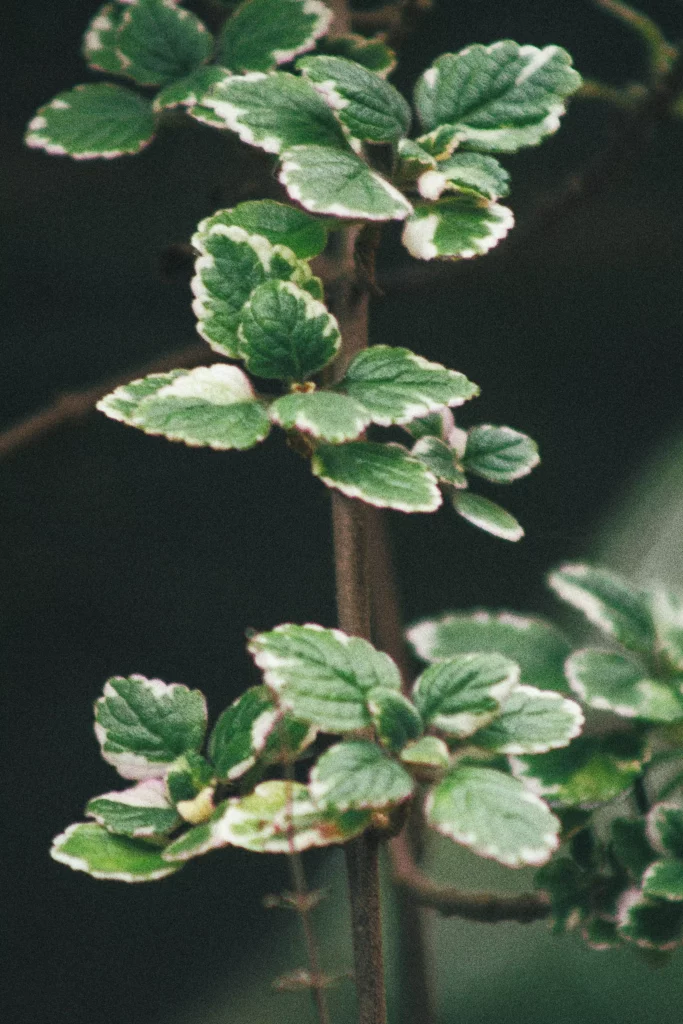
Roślina z gatunków kwitnących, która działa na komary odstraszająco to powszechnie wykorzystywana do ozdoby okien, balkonów i tarasów pelargonia (Pelargonium). Jest łatwa w uprawie, dostępna w wielu barwach, a umieszczona jako element dekoracyjny przy oknach tworzy niewidzialną moskitierę.
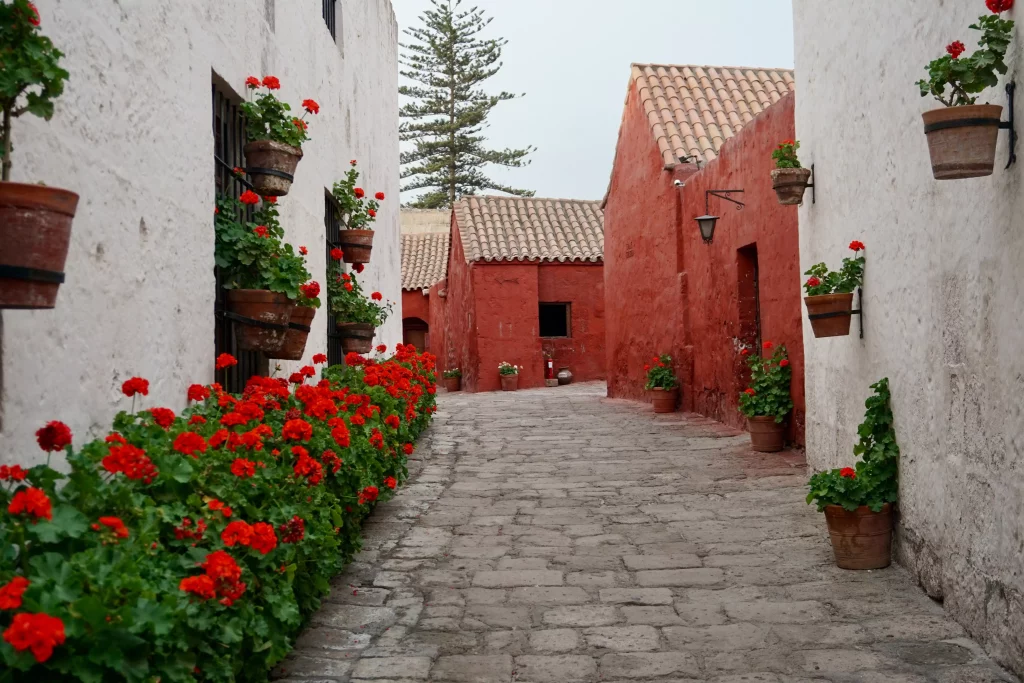
Kolejnymi kwitnącymi pozycjami w tej kategorii jest lawenda wąskolistna (Lavandula), bodziszek korzeniasty (Geranium macrorrhizum) oraz kocimiętka Fassena (Nepeta faassenii). Wszystkie należą do roślin mało wymagających oraz długo kwitnących. Posadzone w większej grupie stworzą przepiękną rabatę przyciągającą wzrok dzięki obfitemu kwitnieniu w różnych tonacjach niebieskiego koloru.
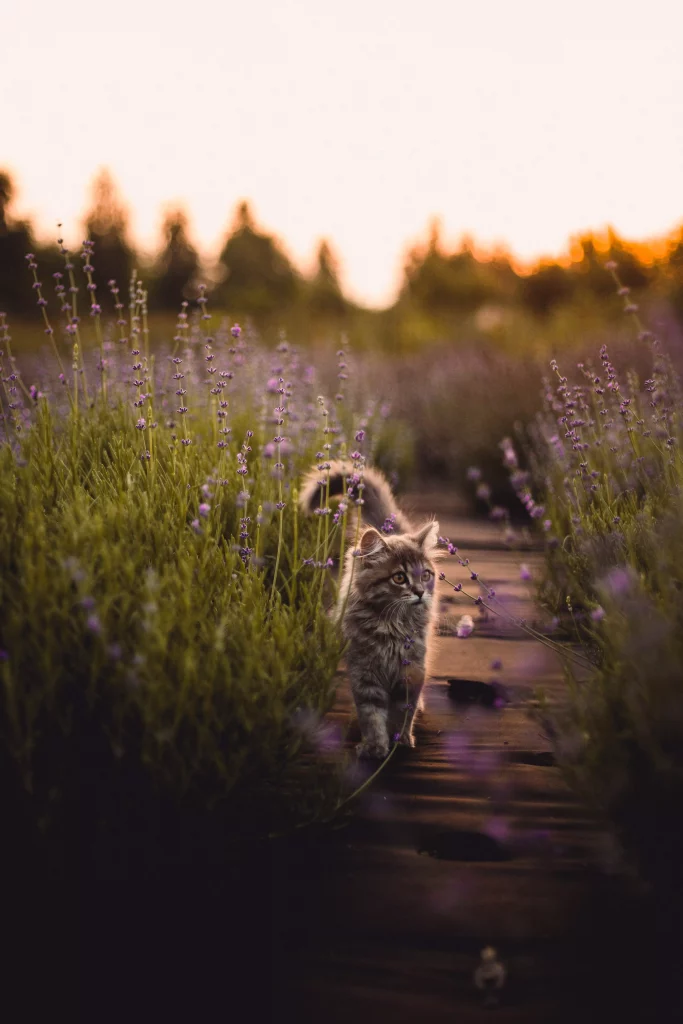
Uprawa roślin odstraszających komary to oczywiście jeden z wielu sposobów walki o zapewnienie większego komfortu wypoczynku w okresie letnim. Nie zapewni ona jednak pełnej ochrony, może tylko zmniejszyć poziom problemu w sposób naturalny przy okazji podnosząc atrakcyjność miejsca.
Wiosna to doskonały czas na zakładanie ogrodu, jego modernizację czy uzupełnienie o nowe okazy roślin. Mijająca zima oraz brak sezonowych liści ukazały miejsca bądź obiekty w przestrzeni ogrodowej, które wymagałyby wzbogacenia, urozmaicenia lub osłony odpowiednią roślinnością. Przyjrzyjcie się ogrodowi i zaplanujcie formę zieleni która wprowadzi świeżość oraz podniesie estetykę otoczenia obiektu noclegowego.
Drzewa, krzewy i kwiaty odgrywają dzisiaj bardzo ważną rolę, nadając charakter przestrzeni przez co czynią ją znakomitym miejscem odpoczynku.
Zadbajcie więc o swoje otoczenie i uzupełnijcie je o piękne, tętniące zielenią rośliny dla siebie i gości – bo zieleń to piękno i zdrowie!
Chcesz dowiedzieć się więcej na temat wynajmu krótkoterminowego? Zajrzyj na BedBooking i śledź naszego bloga
